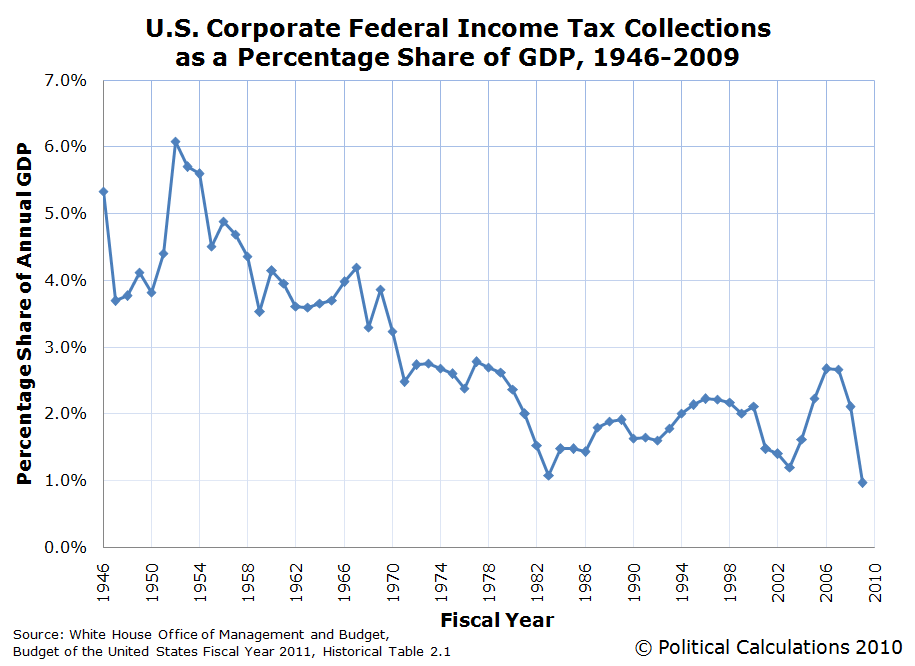Let's begin with a quote today, shall we?
A weak economy, new tax breaks, and aggressive tax sheltering have pushed corporate income tax receipts down to historically low levels, both relative to the size of the economy and as a share of total federal revenues. According to the most recent budget projections of the Congressional Budget Office, corporate revenues will remain at historically low levels even after the economy recovers, and even if the large new corporate tax breaks enacted in 2002 and 2003 are allowed to expire on schedule.
That's an excerpt from an 18-page report produced by the Center on Budget and Policy Priorities. In 2003. Really. And here we are, just over seven years later, and it might as well have been written today.
And it would still be a total crock. In reality, this kind of assertion is based on the old magician's trick of misdirection. "Look here," the master of deception commands, "as I waive my magic laser pointer at the following chart, and you will see with your own eyes that corporate income tax revenues have fallen over time!"

And so it would seem. But do you see the misdirection in what our charming conjurer has said?
The deceit lies in the words "corporate income tax revenues", which you, as a casual observer (aka "the mark"), are meant to take as being the only kind of taxes that corporations and all other businesses pay into the U.S. Treasury's coffers. The con would then continue as our trickster would go on to blame special tax breaks and loopholes as being the major reasons why corporate tax collections have fallen so far over time, not to mention those evil tax cuts lobbied for by those fat cat multinational corporations.
But that completely ignores that the other taxes that all businesses pay have steadily risen over that same period of time, whether by major corporations or limited liability companies or partnerships or even sole proprietors. Which you might not have noticed because you don't see them being paid by corporate America because they're in the background of the magician's stage, so to speak. As it happens, they're the employers' portion of the federal government's payroll taxes, which go by names like "Social Security" and "Medicare", or more simply, "FICA":

And just as surely as you see the deductions for these things on your own paycheck, you can rest assured that your employer has cut a separate check directly to the U.S. Treasury for the same amount. These payments account for one-half of the total amount of payroll taxes collected in every year.
Which brings us to our final chart, in which we reveal just how much the federal government has collected from all of American business as a percent share of GDP since 1946:

We've added the statistical control chart indicators to demonstrate just how consistent the full share of federal taxes paid by American businesses has been over that time. We find the long-term stable average of total corporate tax collections is 5.26% of annual GDP, with a standard deviation of 0.56% of GDP.
Now here's the real story behind that steady picture. Because the U.S. Congress has increased those payroll taxes over time to deal with the problem of a growing population of future beneficiaries for the programs supported by those payroll taxes, they've had to offset what would otherwise be a sharply increased tax burden on American businesses by reducing corporate income taxes. Otherwise, a large number of American businesses would have become completely noncompetitive in the global economy.
Sometimes, they've done that directly by cutting the corporate income tax rates, but mostly, elected politicians have found that it is more profitable for themselves to complicate the tax code by creating special loopholes that allow the various businesses they favor to avoid paying those taxes. Legally.
This might be one of those very rare situations where the outcome has turned out to be fair on whole, but all the means by which we get there are about as dirty as they can be. Which might make it a unique case study for public choice theory.
Data Sources
Tax Receipts by Source: White House Office of Management and Budget. Budget of the United States Fiscal Year 2011. Table 2.1 - Receipts by Source, 1934-2015.
GDP: White House Office of Management and Budget. Budget of the United States Fiscal Year 2011. Table 1.2 - Summary of Receipts, Outlays and Surpluses or Deficits (-) as Percentages of GDP: 1930-2015.
Elsewhere
Update: Tom Blumer fills in the gap for what actually happened with corporate tax collections between 2003 and today.
Labels: business, quality, taxes
Welcome to the blogosphere's toolchest! Here, unlike other blogs dedicated to analyzing current events, we create easy-to-use, simple tools to do the math related to them so you can get in on the action too! If you would like to learn more about these tools, or if you would like to contribute ideas to develop for this blog, please e-mail us at:
ironman at politicalcalculations
Thanks in advance!
Closing values for previous trading day.
This site is primarily powered by:
CSS Validation
RSS Site Feed
JavaScript
The tools on this site are built using JavaScript. If you would like to learn more, one of the best free resources on the web is available at W3Schools.com.